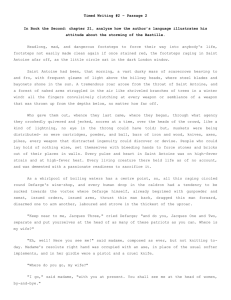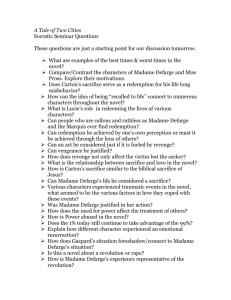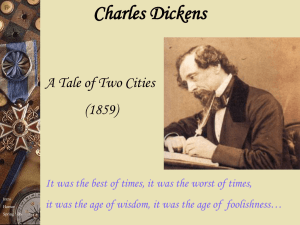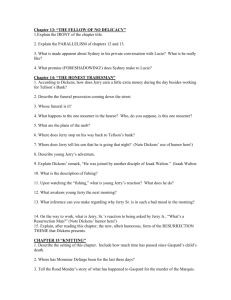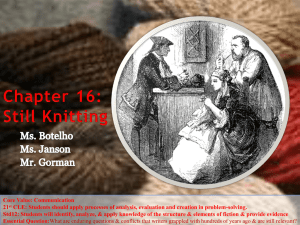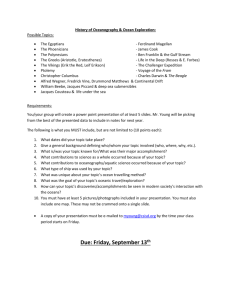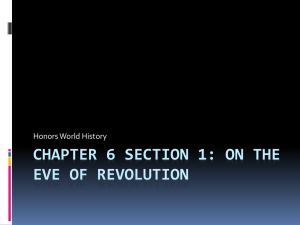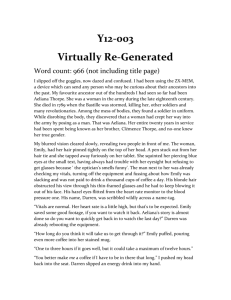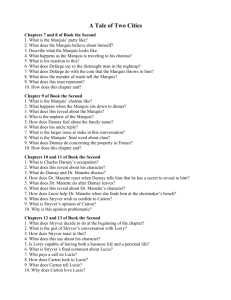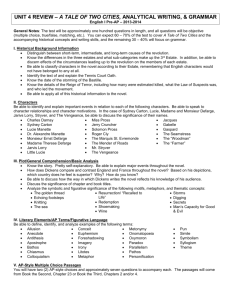A Tale of Two Cities
advertisement
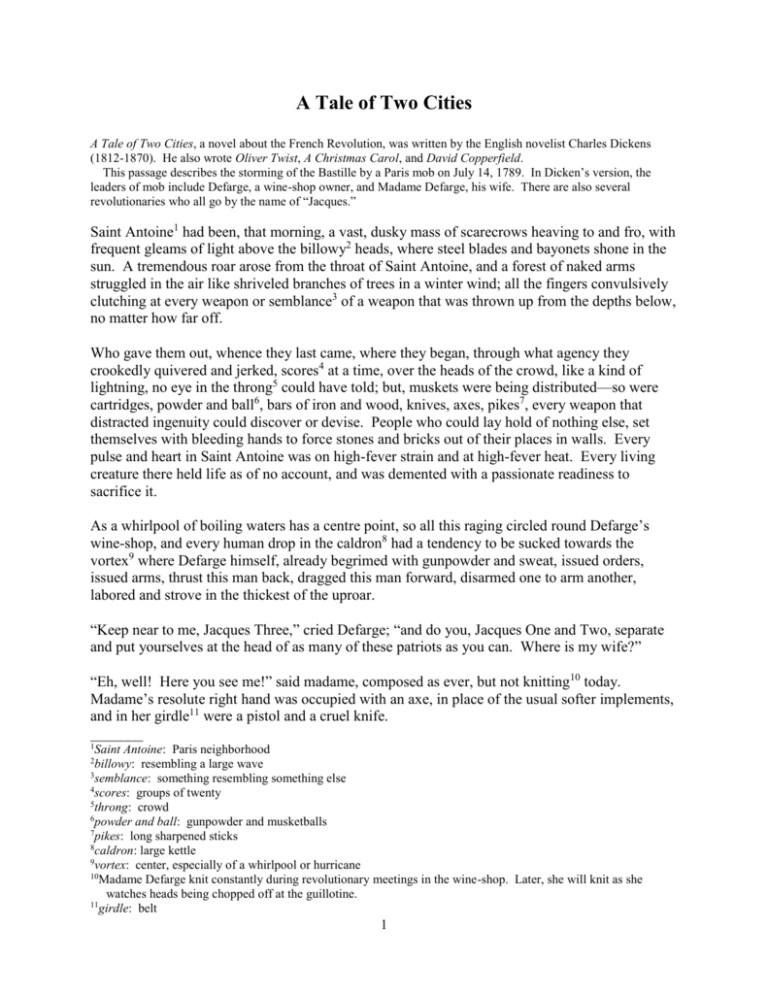
A Tale of Two Cities A Tale of Two Cities, a novel about the French Revolution, was written by the English novelist Charles Dickens (1812-1870). He also wrote Oliver Twist, A Christmas Carol, and David Copperfield. This passage describes the storming of the Bastille by a Paris mob on July 14, 1789. In Dicken’s version, the leaders of mob include Defarge, a wine-shop owner, and Madame Defarge, his wife. There are also several revolutionaries who all go by the name of “Jacques.” Saint Antoine1 had been, that morning, a vast, dusky mass of scarecrows heaving to and fro, with frequent gleams of light above the billowy2 heads, where steel blades and bayonets shone in the sun. A tremendous roar arose from the throat of Saint Antoine, and a forest of naked arms struggled in the air like shriveled branches of trees in a winter wind; all the fingers convulsively clutching at every weapon or semblance3 of a weapon that was thrown up from the depths below, no matter how far off. Who gave them out, whence they last came, where they began, through what agency they crookedly quivered and jerked, scores4 at a time, over the heads of the crowd, like a kind of lightning, no eye in the throng5 could have told; but, muskets were being distributed—so were cartridges, powder and ball6, bars of iron and wood, knives, axes, pikes7, every weapon that distracted ingenuity could discover or devise. People who could lay hold of nothing else, set themselves with bleeding hands to force stones and bricks out of their places in walls. Every pulse and heart in Saint Antoine was on high-fever strain and at high-fever heat. Every living creature there held life as of no account, and was demented with a passionate readiness to sacrifice it. As a whirlpool of boiling waters has a centre point, so all this raging circled round Defarge’s wine-shop, and every human drop in the caldron8 had a tendency to be sucked towards the vortex9 where Defarge himself, already begrimed with gunpowder and sweat, issued orders, issued arms, thrust this man back, dragged this man forward, disarmed one to arm another, labored and strove in the thickest of the uproar. “Keep near to me, Jacques Three,” cried Defarge; “and do you, Jacques One and Two, separate and put yourselves at the head of as many of these patriots as you can. Where is my wife?” “Eh, well! Here you see me!” said madame, composed as ever, but not knitting10 today. Madame’s resolute right hand was occupied with an axe, in place of the usual softer implements, and in her girdle11 were a pistol and a cruel knife. _______ 1 Saint Antoine: Paris neighborhood billowy: resembling a large wave 3 semblance: something resembling something else 4 scores: groups of twenty 5 throng: crowd 6 powder and ball: gunpowder and musketballs 7 pikes: long sharpened sticks 8 caldron: large kettle 9 vortex: center, especially of a whirlpool or hurricane 10 Madame Defarge knit constantly during revolutionary meetings in the wine-shop. Later, she will knit as she watches heads being chopped off at the guillotine. 11 girdle: belt 2 1 “Where do you go, my wife?” “I go,” said madame, “with you at present. You shall see me at the head of women, by-and-by.” “Come, then!” cried Defarge, in a resounding voice. “Patriots and friends, we are ready! The Bastille!” With a roar that sounded as if all the breath in France had been shaped into the detested word, the living sea rose, wave on wave, depth on depth, and overflowed the city to the point. Alarm-bells ringing, drums beating, the sea raging and thundering on its new beach, the attack begun. Deep ditches, double drawbridge, massive stone walls, eight great towers, cannon, muskets, fire and smoke. Through the fire and through the smoke—in the fire and in the smoke, for the sea cast him up against a cannon, and on the instant he became a cannonier—Defarge of the wineshop worked like a manful soldier, two fierce hours. Deep ditch, single drawbridge, massive stone walls, eight great towers, cannon, muskets, fire and smoke. One drawbridge down! “Work, comrades all, work! Work, Jacques One, Jacques Two, Jacques One Thousand, Jacques Two Thousand, Jacques Five-and-Twenty Thousand; in the name of all the Angels or the Devils—which you prefer—work!” Thus Defarge of the wineshop, still at his gun, which had long grown hot. “To me, women!” cried madame his wife. “What! We can kill as well as the men when the place is taken!” And to her, with a shrill thirsty cry, trooping women variously armed, but all armed alike in hunger and revenge. Cannon, muskets, fire and smoke; but, still the deep ditch, the single drawbridge, the massive stone walls, and the eight great towers. Slight displacements12 of the raging sea, made by the falling wounded. Flashing weapons, blazing torches, smoking wagonloads of wet straw, hard work at neighbouring barricades in all directions, shrieks, volleys, execrations13, bravery without stint14, boom, smash and rattle, and the furious sounding of the living sea; but, still the deep ditch and the single drawbridge, and the massive stone walls, and the eight great towers, and still Defarge of the wine-shop at his gun, grown doubly hot by the service of four fierce hours. A white flag from within the fortress, and a parley15—this dimly perceptible through the raging storm, nothing audible in it—suddenly the sea rose immeasurable wider and higher, and swept Defarge of the wine-shop over the lowered drawbridge, past the massive stone outer walls, in among the eight great towers surrendered! So resistless was the force of the ocean baring him on, that even to draw his breath or turn his head was as impracticable16 as if he had been struggling in the surf at the South Sea, until he was landed in the outer court-yard of the Bastille. There, against an angle of a wall, he made a _______ 12 displacements: shifts, movements execrations: curses 14 stint: limit, restriction 15 parley: discussion with the enemy 16 impracticable: unable to be done 13 2 struggle to look about him. Jacques Three was nearly at his side; Madame Defarge, still heading some of her women, was visible in the inner distance, and her knife was in her hand. Everywhere was tumult,17 exultation, deafening and maniacal bewilderment, astounding noise, yet furious dumb-show18. “The Prisoners!” The Records!” “The secret cells!” “The instruments of torture!” The Prisoners!” Of all these cries, and ten thousand incoherencies19, “The Prisoners!” was the cry most taken up by the sea that rushed in. [Later, the mob captures the governor of the Bastille—a “grim old officer”—and carries him to Saint Antoine.] In the howling universe of passion and contention20 that seemed to encompass21 this grim old officer conspicuous in his grey coat and red decoration, there was but one quite steady figure, and that was a woman’s. “See, there is my husband!” she cried, pointing him out. “See Defarge!” She stood immovable close to the grim old officer, and remained immovable close to him; remained immovable close to him through the streets, as Defarge and the rest bore him along; remained immovable close to him when he was got near his destination, and began to be struck at from behind; remained immovable close to him when the long-gathering rain of stabs and blows fell heavy; was so close to him when he dropped dead under it, that, suddenly animated, she put her foot upon his neck, and with her cruel knife—long ready—hewed off his head. _______ 17 tumult: great noise, uproar dumb-show: communication by gestures 19 incoherencies: spoken words that can’t be understood 20 contention: argument 21 encompass: surround on all sides 18 Write your answers to the following questions on a separate sheet of paper. Comprehension 1. To what does Dickens compare the crowd as it storms the Bastille? Give examples of the words that make this comparison. 2. (a) What obstacles does the mob face in entering the Bastille? (b) How do they finally get inside? (c) How long does it take? 3. How much control does Defarge have over the crowd? 3 Critical Thinking 1. From your reading of this passage, what feelings were behind the action of the mob in storming the Bastille? 2. (a) Compare the characters of Defarge and Madame Defarge as shown in this passage. (b) What point do you think Dickens was making about the women who took part in the French Revolution? 3. Do you think Dickens was sympathetic or unsympathetic to the poor people of Paris? Explain. 4. Reread the account of the storming of the Bastille. (a) Do you think Dicken’s version is probably accurate or inaccurate? Why? (b) Do you think historical fiction like this can be a helpful tool in understanding historical events? 4
